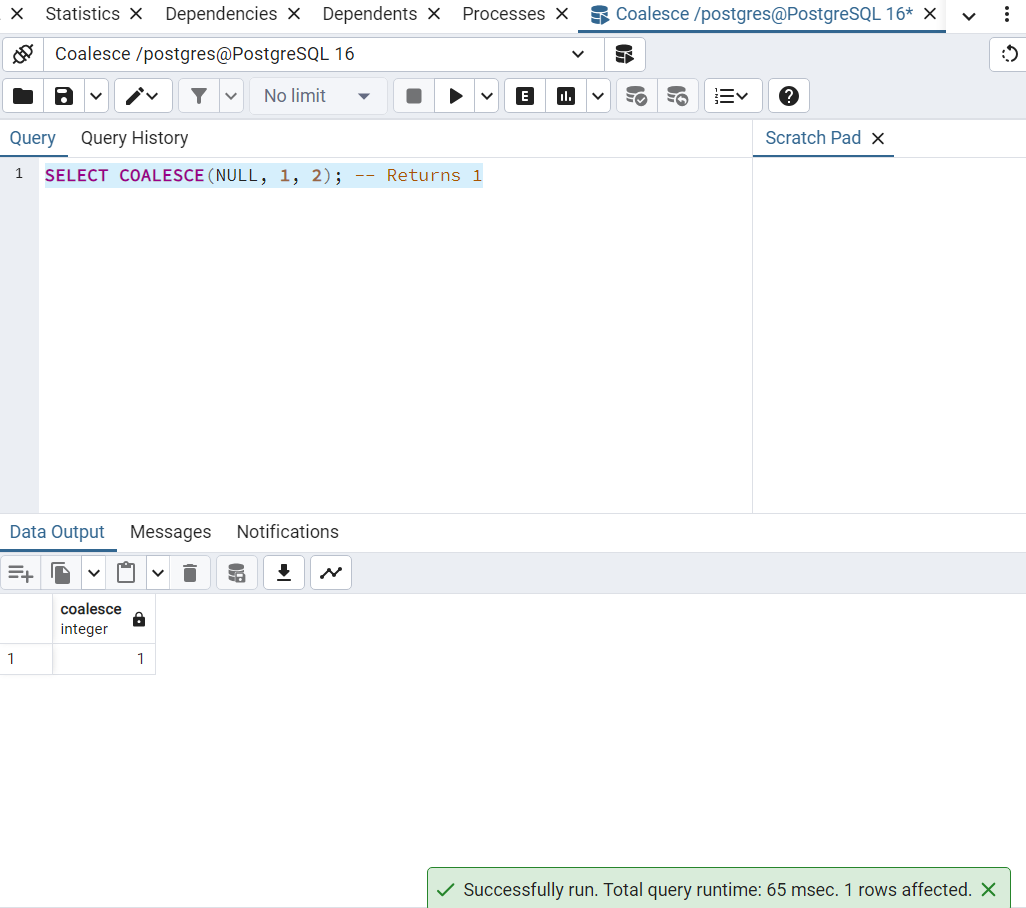Working professionals
Fresh graduates
- Study abroad
- Offline centres
More
1. SQL Tutorial
3. SQL Commands
5. SQL Aliases
10. SQL WHERE Clause
11. SQL AND Operator
13. SQL Like
16. MySQL Workbench
22. Index in SQL
24. Schema in SQL
31. SQL ORDER BY
38. NVL in SQL
41. SQL Wildcards
45. GROUP BY in SQL
46. SQL HAVING
47. EXISTS in SQL
48. SQL Joins
53. Self Join SQL
54. Left Join in SQL
57. Cursor in SQL
58. Triggers In SQL
61. REPLACE in SQL
63. Transact-SQL
64. INSTR in SQL
70. Advanced SQL
71. SQL Subquery
78. MySQL database
79. What is SQLite
80. SQLite
Understanding and Mastering COALESCE in SQL
Introduction
As a data analyst with over a decade of experience, I've encountered countless situations where handling NULL values in SQL databases was crucial for accurate data analysis and reporting. One of the most powerful tools in my arsenal for managing NULLs is the COALESCE function. In this comprehensive tutorial, we'll explore COALESCE in SQL, its practical applications, best practices, and performance considerations.
To set the stage, let's create a sample database and populate it with some data that we'll use throughout this tutorial to illustrate the usage and benefits of COALESCE.
Sample DB we have to use in this tutorial
CREATE TABLE employees (
id INT PRIMARY KEY,
first_name VARCHAR(50),
last_name VARCHAR(50),
email VARCHAR(100),
phone VARCHAR(20),
department VARCHAR(50),
salary DECIMAL(10,2)
);
INSERT INTO employees (id, first_name, last_name, email, phone, department, salary)
VALUES
(1, 'John', 'Doe', 'john.doe@company.com', '555-1234', 'Sales', 50000),
(2, 'Jane', 'Smith', 'jane.smith@company.com', NULL, 'Marketing', 60000),
(3, 'Mike', 'Johnson', NULL, '555-5678', 'Engineering', 75000),
(4, 'Emily', 'Brown', 'emily.brown@company.com', NULL, NULL, 55000),
(5, 'David', 'Wilson', 'david.wilson@company.com', '555-2468', 'Sales', NULL);
Output
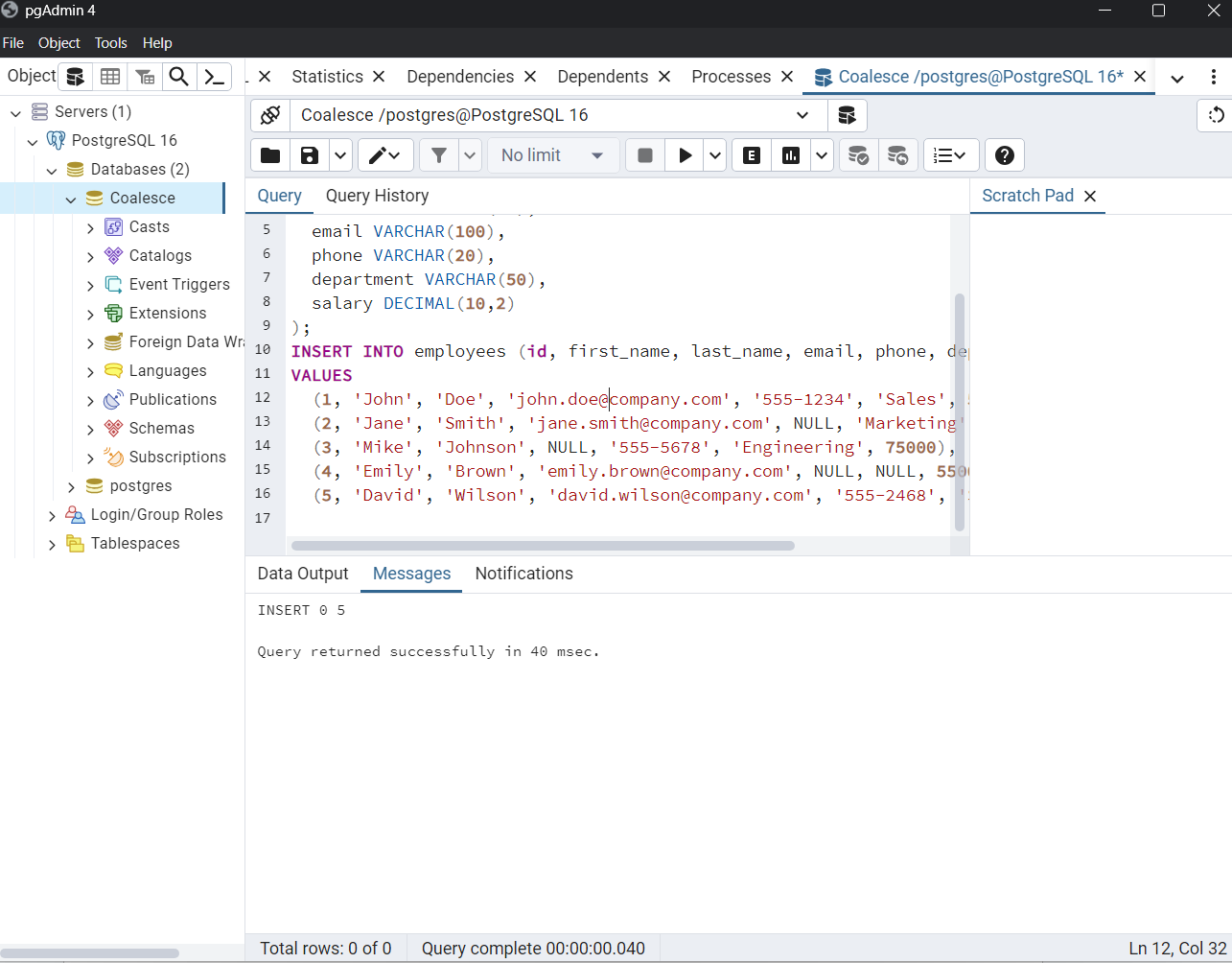
What is COALESCE?
COALESCE is a SQL function that returns the first non-NULL value from a list of expressions. Its basic syntax is as follows:
COALESCE(expression1, expression2, ..., expressionN)
The function evaluates the expressions from left to right until it encounters a non-NULL value, and then returns that value. If all expressions are NULL, COALESCE returns NULL.
Here's a simple example to illustrate the concept:
SELECT COALESCE(NULL, 'Hello', 'World'); -- Returns 'Hello'
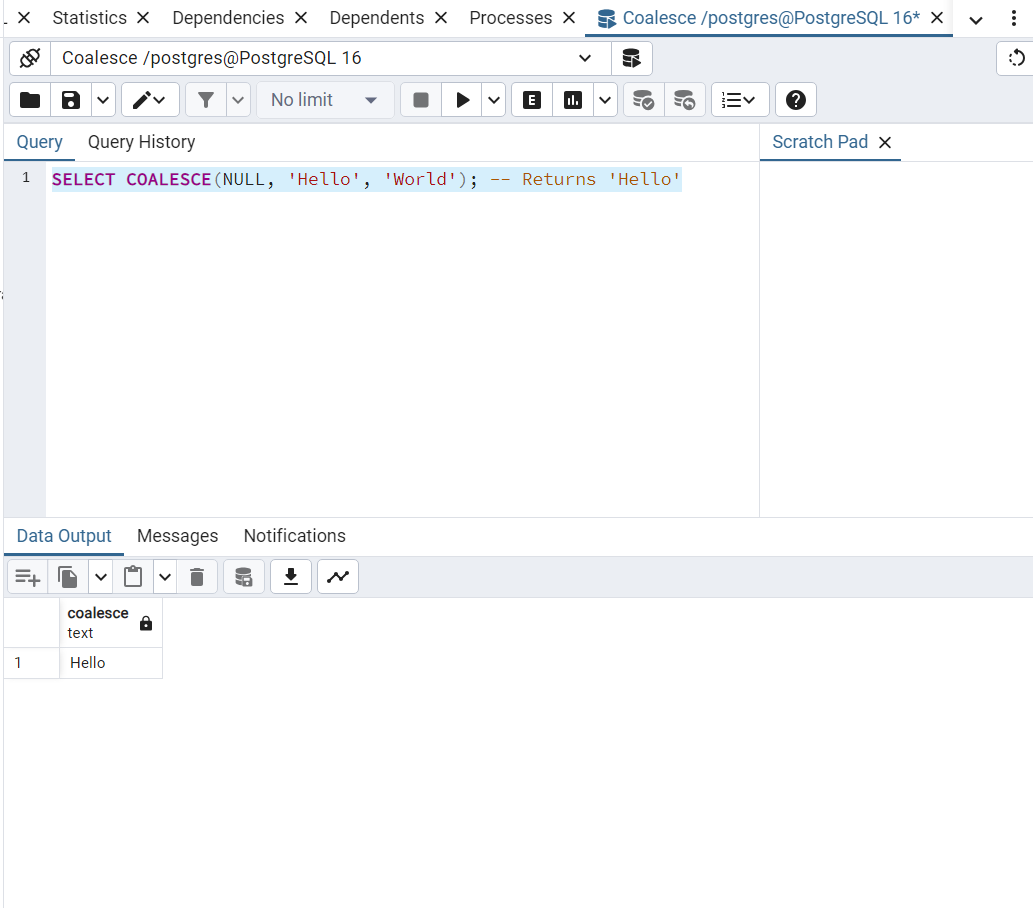
In this case, COALESCE checks the first expression (NULL), finds it to be NULL, and moves on to the second expression ('Hello'), which is non-NULL, and thus returns 'Hello'.
How COALESCE Works
Under the hood, COALESCE is essentially a shorthand for a CASE expression that checks each expression for NULL values. Here's how the previous example would look using a CASE expression:
SELECT
CASE
WHEN NULL IS NOT NULL THEN NULL
WHEN 'Hello' IS NOT NULL THEN 'Hello'
ELSE 'World'
END;
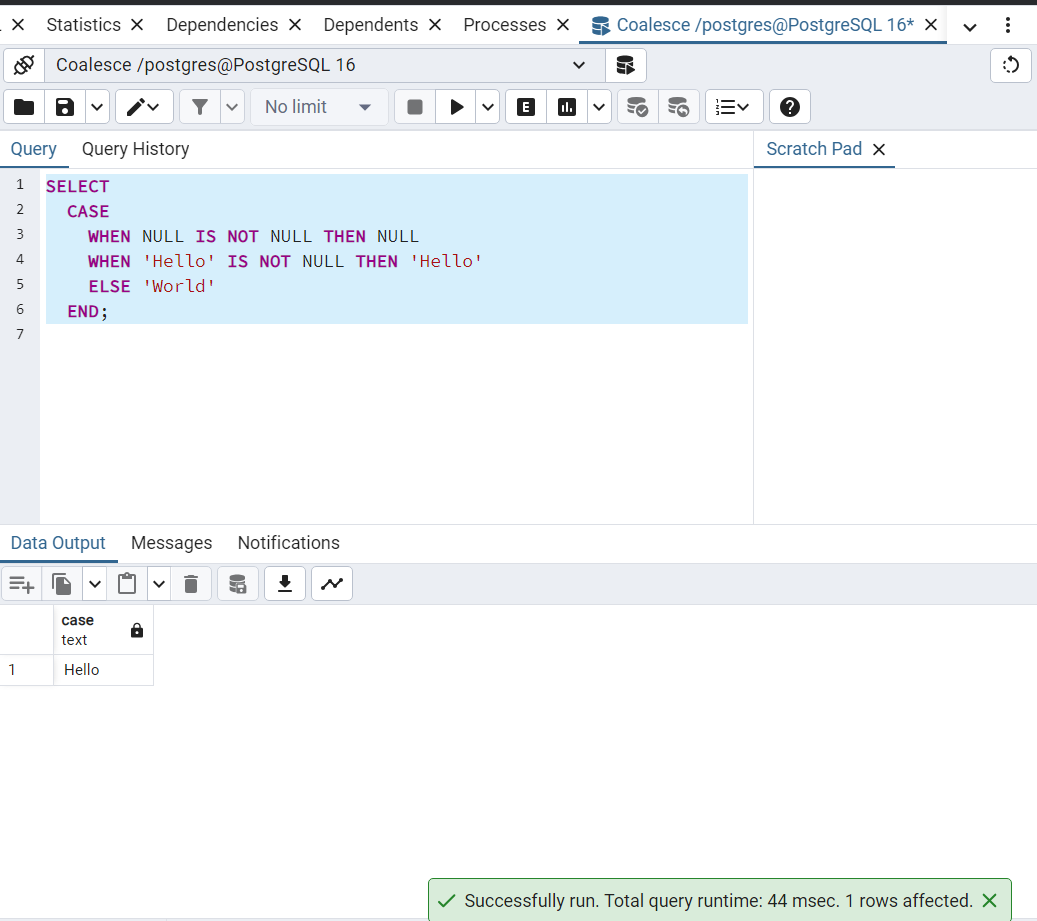
While the CASE expression achieves the same result, COALESCE provides a more concise and readable way to handle NULL values.
Practical Applications of COALESCE in SQL
Handling NULL Values
One of the most common use cases for COALESCE is dealing with NULL values in columns. Suppose we want to retrieve employee names from our sample database, but some employees might have first or last names missing. We can use COALESCE to return a default value instead of NULL:
SELECT
COALESCE(first_name, 'N/A') AS first_name,
COALESCE(last_name, 'N/A') AS last_name
FROM employees;
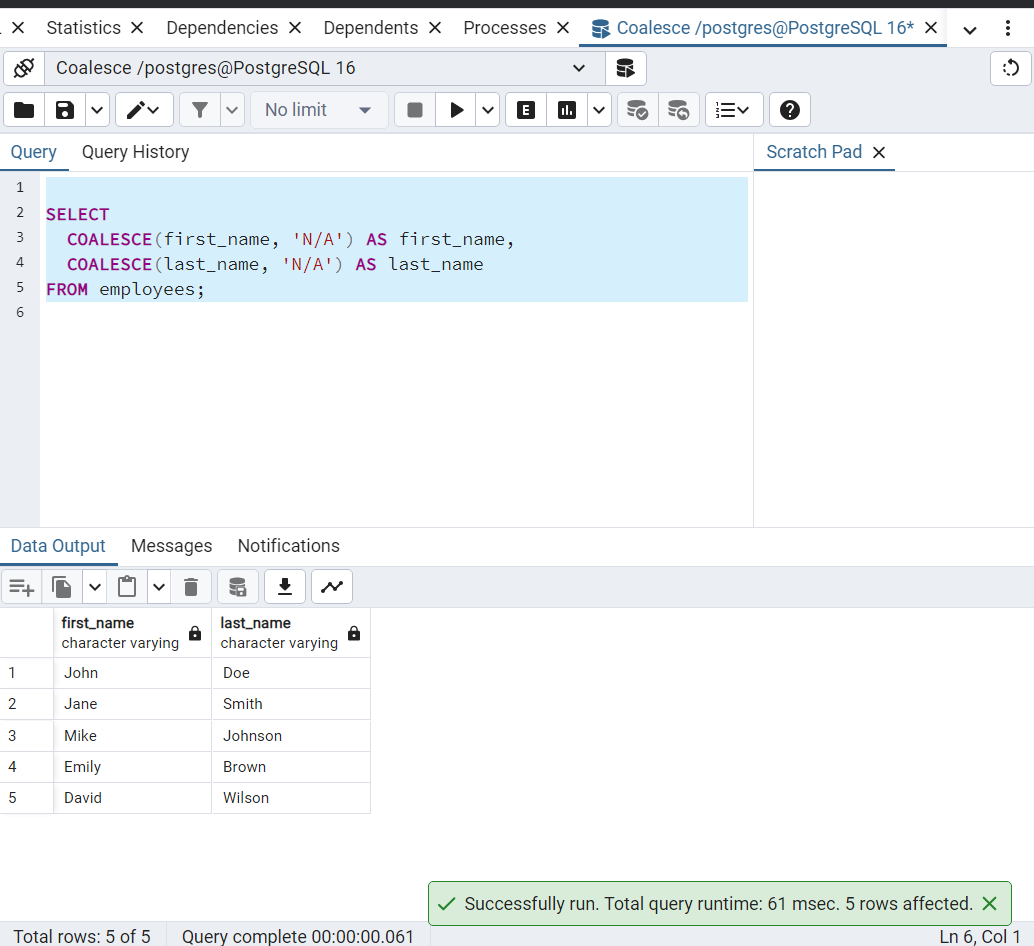
This query will return 'N/A' for any missing first or last names, making the output more readable and easier to process.
Coalescing Multiple Columns
Another useful application of COALESCE is combining values from multiple columns into a single column. Let's say we want to retrieve a single contact detail for each employee, prioritizing email over the phone. We can achieve this using COALESCE:
SELECT
first_name,
last_name,
COALESCE(email, phone, 'No contact info') AS contact
FROM employees;

In this example, COALESCE checks the email column first, and if it's not NULL, returns the email value. If email is NULL, it moves on to the phone column. If both email and phone are NULL, it returns the default value 'No contact info'.
Advanced Uses of COALESCE
COALESCE in Different SQL Databases
While the basic functionality of COALESCE remains the same across SQL databases, there might be slight differences in syntax or behavior. Here are a few examples:
PostgreSQL (coalesce sql postgres)
SELECT COALESCE(NULL, 1, 2); -- Returns 1
SQL Server (coalesce mssql)
SELECT COALESCE(NULL, 'Hello', 'World'); -- Returns 'Hello'

MySQL
SELECT COALESCE(NULL, 1, 2); -- Returns 1

COALESCE with Expressions and Functions
COALESCE can also be used with expressions and functions to provide more advanced functionality. For example, you can use COALESCE with the LENGTH function to return the length of the first non-NULL string:
SELECT COALESCE(LENGTH('Hello'), LENGTH('World')); -- Returns 5
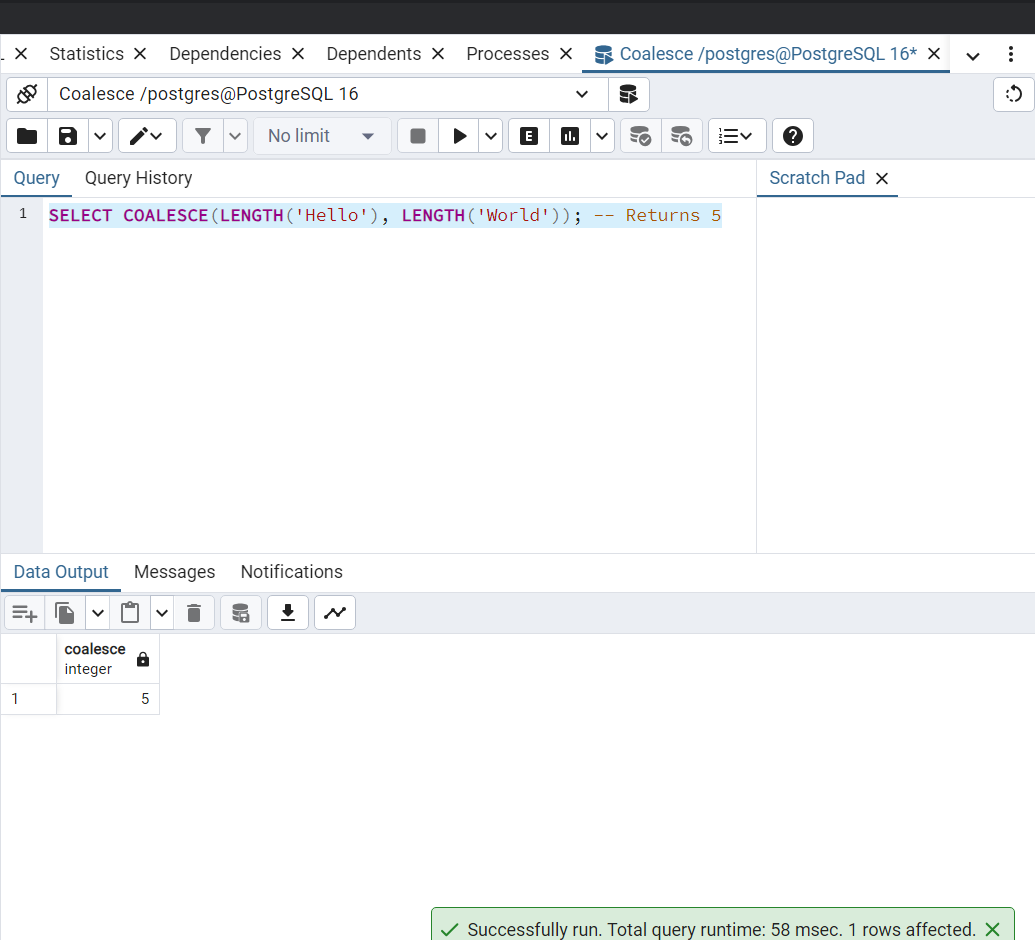
COALESCE vs. Other SQL Functions
COALESCE and NULLIF
NULLIF is another SQL function that is often used in conjunction with COALESCE. NULLIF returns NULL if the two expressions are equal. Otherwise it returns the first expression. Here's an example:
SELECT COALESCE(NULLIF(first_name, 'John'), 'Unknown') AS first_name
FROM employees;

Feature | COALESCE | NULLIF |
Purpose | Returns the first non-NULL expression from a list of expressions. | Returns NULL if the two expressions are equal, otherwise returns the first expression. |
Syntax | COALESCE(expression1, expression2, ..., expressionN) | NULLIF(expression1, expression2) |
Use Case | Handling NULL values and providing default values when necessary. | Treating specific values as NULL based on a condition. |
Return Value | The first non-NULL expression from the list. | NULL if the expressions are equal, otherwise the first expression. |
Example | COALESCE(NULL, 'Hello', 'World')<br>Returns: 'Hello' | NULLIF('Hello', 'Hello')<br>Returns: NULL |
Combining with COALESCE | - | COALESCE(NULLIF(expression1, expression2), default_value) |
In this case, if an employee's first name is 'John', NULLIF returns NULL, and COALESCE then returns 'Unknown'. For all other first names, COALESCE returns the original first name.
COALESCE vs. ISNULL/IFNULL
Some SQL databases have their own functions for handling NULL values, such as ISNULL in SQL Server and IFNULL in MySQL. These functions work similarly to COALESCE
Function | Database | Syntax | Description |
COALESCE | Standard SQL | COALESCE(expression1, expression2, ..., expressionN) | Returns the first non-NULL expression from the list of expressions. Widely supported across databases. |
ISNULL | SQL Server | ISNULL(expression, replacement_value) | Returns the replacement_value if the expression is NULL. Specific to SQL Server. |
IFNULL | MySQL | IFNULL(expression, replacement_value) | Returns the replacement_value if the expression is NULL. Specific to MySQL. |
While these functions can be used interchangeably with COALESCE in most cases, COALESCE is more widely supported across different SQL databases, making it a more portable option.
Best Practices and Performance Considerations
When using COALESCE in your SQL queries, keep these best practices and performance considerations in mind:
- Order expressions from most likely to least likely to be non-NULL. This can help optimize query performance by reducing the number of expressions COALESCE needs to evaluate.
- Be mindful of data types. All expressions in a COALESCE function should be of compatible data types to avoid implicit conversions that can impact performance.
- Use COALESCE judiciously. While it's a powerful tool, overusing COALESCE can make queries more complex and harder to read. Use it when it truly simplifies your queries and improves readability.
- Consider indexing. If you frequently use COALESCE on certain columns in your WHERE clauses, consider creating indexes on those columns to improve query performance.
Conclusion
In this tutorial, we've explored the COALESCE function in SQL, its syntax, and its practical applications. We've seen how COALESCE can handle NULL values, combine values from multiple columns, and work with expressions and functions. We've also compared COALESCE to other SQL functions like NULLIF and ISNULL/IFNULL, and discussed best practices and performance considerations.
By mastering COALESCE, you'll be well-equipped to handle NULL values effectively in your SQL queries, leading to cleaner, more efficient, and more robust database management. So go forth and put your newfound COALESCE knowledge to good use!
Final Thoughts on Mastering COALESCE in SQL
As with any powerful tool, the key to success with COALESCE is knowing when and how to use it effectively. By understanding its strengths, limitations, and best practices, you can make informed decisions about incorporating COALESCE into your SQL toolkit.
Remember, the goal is not just to write queries that work but to write queries that are efficient, maintainable, and scalable. By leveraging COALESCE judiciously and following best practices, you'll be well on your way to achieving those goals and becoming a true SQL master.
FAQs
1. How do I coalesce two columns in SQL?
To coalesce two columns in SQL, you can use the COALESCE function and specify the columns as arguments. For example: SELECT first_name, last_name, COALESCE(email, phone) AS contact FROM employees; In this case, COALESCE will return the value from the email column if it's not NULL. Otherwise, it will return the value from the phone column.
2. What is NULLIF and COALESCE in SQL?
NULLIF is a SQL function that returns NULL if the two arguments are equal. If not, it returns the first argument. COALESCE, on the other hand, returns the first non-NULL argument from a list of expressions. Here's an example that combines NULLIF and COALESCE: SELECT COALESCE(NULLIF(first_name, 'John'), 'Unknown') AS first_name FROM employees; In this case, if an employee's first name is 'John', NULLIF returns NULL, and COALESCE then returns 'Unknown'. For all other first names, COALESCE returns the original first name.
3. What is COALESCE in SQL with an example?
COALESCE is a SQL function that returns the first non-NULL argument from a list of expressions. Here's a simple example: SELECT COALESCE(NULL, 'Hello', 'World'); -- Returns 'Hello' SELECT COALESCE(NULL, 'Hello', 'World'); -- Returns 'Hello' In this case, COALESCE evaluates the arguments from left to right and returns 'Hello', which is the first non-NULL argument.
4. Is COALESCE faster than NULL?
COALESCE is not inherently faster or slower than using NULL. Its performance depends on factors such as the number of arguments, the complexity of the expressions, and the overall query structure. However, using COALESCE can help simplify queries and make them more readable, indirectly leading to better performance by making the queries easier to optimize.
5. Why do we need COALESCE in SQL?
We need COALESCE in SQL to handle NULL values effectively and provide default values when necessary. Some common use cases for COALESCE include: Replacing NULL values with a default value for display or calculation purposesCombining values from multiple columns into a single columnHandling NULL values in JOIN conditions or WHERE clauses Replacing NULL values with a default value for display or calculation purposes Combining values from multiple columns into a single column Handling NULL values in JOIN conditions or WHERE clauses By using COALESCE, we can write more robust and readable SQL queries that deal with NULL values gracefully.
6. What is the advantage of COALESCE in SQL?
The main advantages of using COALESCE in SQL are: Simplifying NULL handling: COALESCE provides a concise and readable way to handle NULL values in SQL queries, making the code cleaner and easier to understand.Providing default values: COALESCE allows you to specify default values when an expression evaluates to NULL, ensuring that your queries always return meaningful results.Improving query portability: COALESCE is widely supported across different SQL databases, making it a more portable option than database-specific functions like ISNULL or IFNULL. Simplifying NULL handling: COALESCE provides a concise and readable way to handle NULL values in SQL queries, making the code cleaner and easier to understand. Providing default values: COALESCE allows you to specify default values when an expression evaluates to NULL, ensuring that your queries always return meaningful results. Improving query portability: COALESCE is widely supported across different SQL databases, making it a more portable option than database-specific functions like ISNULL or IFNULL.
7. Can COALESCE return NULL?
Yes, COALESCE can return NULL if all of its arguments are evaluated to NULL. For example: SELECT COALESCE(NULL, NULL, NULL); -- Returns NULL SELECT COALESCE(NULL, NULL, NULL); -- Returns NULL In this case, since all arguments are NULL, COALESCE returns NULL.
8. Can COALESCE return multiple values?
No, COALESCE returns only a single value, which is the first non-NULL argument from the list of expressions. If you need to return multiple values based on different conditions, you can use a CASE expression or multiple COALESCE functions in separate columns.
9. How do I replace COALESCE in SQL?
If you need to replace COALESCE in SQL, you can use a CASE expression to achieve similar functionality. For example, instead of: SELECT COALESCE(email, phone, 'No contact info') AS contact FROM employees; You could use: SELECT CASE WHEN email IS NOT NULL THEN email WHEN phone IS NOT NULL THEN phone ELSE 'No contact info' END AS contact FROM employees; While this approach works, COALESCE is generally more concise and readable for handling NULL values.
10. What is the limit of COALESCE in SQL?
The SQL standard does not explicitly limit the number of arguments that can be passed to COALESCE. However, practical limits may exist based on the specific SQL database implementation and the available system resources. It's generally a good practice to keep the number of arguments in COALESCE reasonable and to prioritize readability and maintainability when constructing complex COALESCE expressions.
Author|0


upGrad Learner Support
Talk to our experts. We are available 7 days a week, 10 AM to 7 PM
Indian Nationals
Foreign Nationals
Disclaimer
The above statistics depend on various factors and individual results may vary. Past performance is no guarantee of future results.
The student assumes full responsibility for all expenses associated with visas, travel, & related costs. upGrad does not .






















-7f4b4f34e09d42bfa73b58f4a230cffa.webp&w=128&q=75)
-ae8d039bbd2a41318308f8d26b52ac8f.svg)

